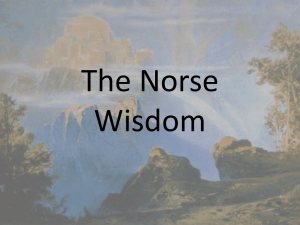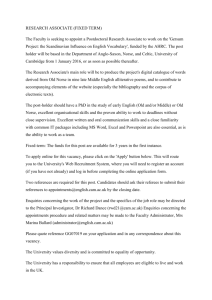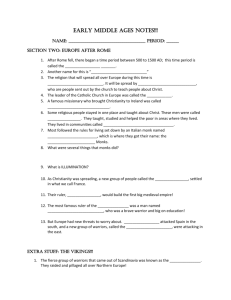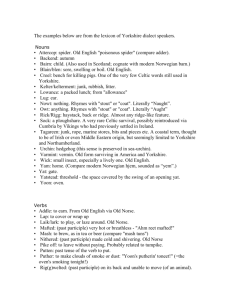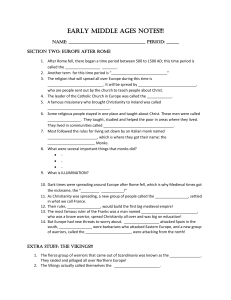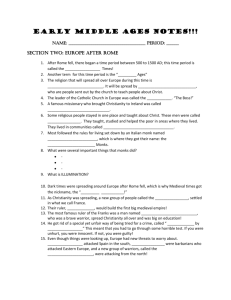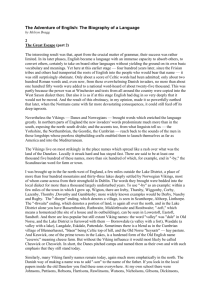Indicators of Ecclesiastical and Norse Settlement and History
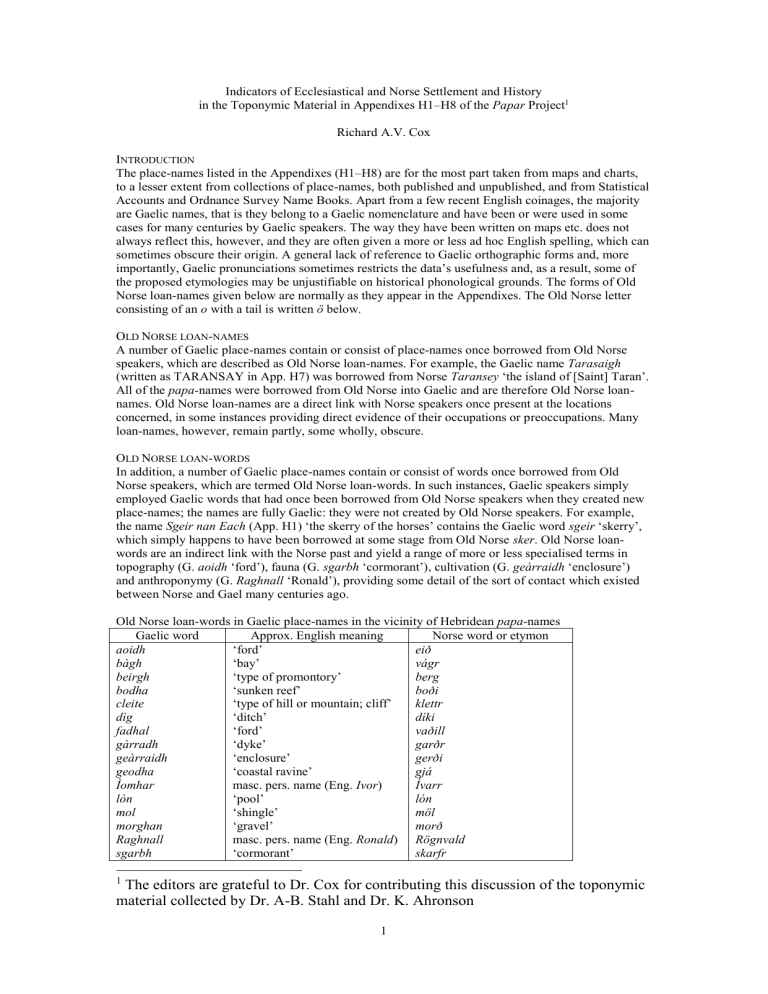
Indicators of Ecclesiastical and Norse Settlement and History in the Toponymic Material in Appendixes H1–H8 of the Papar Project 1
Richard A.V. Cox
I NTRODUCTION
The place-names listed in the Appendixes (H1–H8) are for the most part taken from maps and charts, to a lesser extent from collections of place-names, both published and unpublished, and from Statistical
Accounts and Ordnance Survey Name Books. Apart from a few recent English coinages, the majority are Gaelic names, that is they belong to a Gaelic nomenclature and have been or were used in some cases for many centuries by Gaelic speakers. The way they have been written on maps etc. does not always reflect this, however, and they are often given a more or less ad hoc English spelling, which can sometimes obscure their origin. A general lack of reference to Gaelic orthographic forms and, more importantly, Gaelic pronunciations sometimes restricts the data’s usefulness and, as a result, some of the proposed etymologies may be unjustifiable on historical phonological grounds. The forms of Old
Norse loan-names given below are normally as they appear in the Appendixes. The Old Norse letter consisting of an o with a tail is written ö below.
O LD N ORSE LOAN NAMES
A number of Gaelic place-names contain or consist of place-names once borrowed from Old Norse speakers, which are described as Old Norse loan-names. For example, the Gaelic name Tarasaigh
(written as TARANSAY in App. H7) was borrowed from Norse Taransey ‘the island of [Saint] Taran’.
All of the papanames were borrowed from Old Norse into Gaelic and are therefore Old Norse loannames. Old Norse loan-names are a direct link with Norse speakers once present at the locations concerned, in some instances providing direct evidence of their occupations or preoccupations. Many loan-names, however, remain partly, some wholly, obscure.
O LD N ORSE LOAN WORDS
In addition, a number of Gaelic place-names contain or consist of words once borrowed from Old
Norse speakers, which are termed Old Norse loan-words. In such instances, Gaelic speakers simply employed Gaelic words that had once been borrowed from Old Norse speakers when they created new place-names; the names are fully Gaelic: they were not created by Old Norse speakers. For example, the name Sgeir nan Each (App. H1) ‘the skerry of the horses’ contains the Gaelic word sgeir ‘skerry’, which simply happens to have been borrowed at some stage from Old Norse sker . Old Norse loanwords are an indirect link with the Norse past and yield a range of more or less specialised terms in topography (G. aoidh ‘ford’), fauna (G. sgarbh ‘cormorant’), cultivation (G. geàrraidh ‘enclosure’) and anthroponymy (G. Raghnall ‘Ronald’), providing some detail of the sort of contact which existed aoidh bàgh beirgh bodha cleite dìg fadhal gàrradh geàrraidh geodha
Ìomhar lòn mol morghan between Norse and Gael many centuries ago.
Old Norse loan-words in Gaelic place-names in the vicinity of Hebridean papa -names
Gaelic word
Raghnall sgarbh
Approx. English meaning
‘ford’
‘bay’
‘type of promontory’
‘sunken reef’
‘type of hill or mountain; cliff’
‘ditch’
‘ford’
‘dyke’
‘enclosure’
‘coastal ravine’ masc. pers. name (Eng. Ivor )
‘pool’
‘shingle’
‘gravel’ masc. pers. name (Eng. Ronald )
‘cormorant’
Norse word or etymon eið vágr berg boði klettr díki vaðill garðr gerði gjá
Ívarr lón möl morð
Rögnvald skarfr
1
The editors are grateful to Dr. Cox for contributing this discussion of the toponymic material collected by Dr. A-B. Stahl and Dr. K. Ahronson
1
sgarp sgeir sgor staca tòb tobha tobhta tobhtag
‘barren area’
‘skerry’
‘crevice’
‘stack’
‘bay, creek’
‘type of headland’
‘site; ruins’
‘site; ruins’
The following may also be attested: cuithe rùda greòd
òs riof
‘fold’
‘ram’
‘gravel’
‘river mouth’
‘reef’
*skarpa sker skor stakkr hópr höfði topt topt kví hrútr grjót
óss rif
Note: Gaelic and Old Norse words are cited in their radical or nominative forms.
T HE D ERIVATION OF PAPA NAMES
The forms BAYBLE (§H6) and PAIBLE (§§H7–H8) are in Gaelic Pabail [p h abəl]: ‘The specific element of the ON reconstructions is papa m. a ‘cleric, or religious man’ as found in island-names such as Pabbay. Our names go back to ON * Papýli , as found in the Landnámabók ( í Papíli ...) ... ON Papýli is a syncopated form of * Papabýli and the generic here is ON býli nt. used in the sense ‘domicile, residence’’ (Cox 1994: 44–46).
PABAY (§§H1 and H5) and PABBAY (§§H2–H4) are in Gaelic Pabaigh [p
‘[the] island of the clerics’. h abaj], from ON Papey
A N O VERVIEW OF N ORSE S ETTLEMENT I NDICATORS
With the exception of PAIBLESGARRY and SANDARY, which lie fairly close to PAIBLE in North
Uist (§H8 below), Old Norse loan-names referring specifically to farms or farming-related sites or structures are not attested within the immediate vicinity of papa -name locations. Several examples are found, however, in outlying areas (see §§H1, H6–H8 below).
The presence of Old Norse loan-names (including papa -names) in such numbers generally, and their survival to the present day, assumes a once numerically significant, and most likely continuous, Norse settlement in the areas concerned. (The lack of Old Norse loan-names in PABBAY in South Uist and
PABAY in Skye (§§H3 and H5 below) is unlikely to be significant, as examples occur close by and as examples from the locations themselves may have been lost.)
Old Norse loan-names (other than papa -names) are assumed to be, and (as far as they can be confidently analysed at present) suggest that, they were part of a principally pastoral and fishing economy, one which continued more or less unchanged until the 20th century.
Their presence also indicates that contact between Norse and Gael was (at least ultimately) close enough for their transmission into a Gaelic place-nomenclature, a situation that can be inferred from the presence of loan-words in the Gaelic nomenclature, and one that is found generally within neighbouring areas also. The following list of probable generics in Old Norse loan-names compares favourably with those from other areas.
Probable examples of generic elements in Old Norse loan-names in App. H1–H8
ON generic beirgh bólstaðr býli dalr ey fjall gerði
Approx. English meaning
‘promontory’
‘farm’
‘residence’
‘valley’
‘island’
‘mountain’
‘enclosure; meadow’
Possible examples from App. (H1–H8)
STARABRAIGH (H7)
GARRABOST (H6), KIRKIBOST (H8)
BAYBLE (H6), PAIBLE (H7)
MALADALE (H1), SCARASDALE (H2)
LINGAY (H2), PABBAY (H2)
TAIRAVAL (H1), HERRAVAL (H7)
PAIBLESGARRY (H8)
2
gil gjá holmr hópr klettr möl nes rif sætr sker steinn vatn vík
ærgi
‘ravine’
‘(usually coastal) ravine’
‘island’
‘creek, bay’
‘mountain’
‘shingle’
‘promontory’
‘reef’
‘shieling’
‘skerry’
‘stone’
‘water’
‘bay’
‘milking-place; shieling’ (§H8 below)
CAAGIL (H7)
FIDEGEO (H6), SGARBH-GEO (H7)
TOLM (H7)
ALARIP (H2)
CLETTER (H7), LIANACLETT (H8)
ROSAMOL (H8)
BRIOMANISH (H1), QUINISH (H2)
REEF (H1)
SHEADER (H7), BRINISHADER (H8)
MÀS SGEIR (H1), HUNISGEIR (H6)
HURISTEN (H2), HASTEN (H8)
S(H)AAVAT (H7), TROSAVAT (H8)
UIG (H1), CRAGAVIG (H1)
HORISARY (H8), SANDARY (H8)
Note: Old Norse words are cited in their nominative forms.
A N O VERVIEW OF E CCLESIASTICAL S ETTLEMENT I NDICATORS
The papa -names, which translate as ‘[the] island or the residence of the clerics’, presumably indicate the presence, or at least the erstwhile presence, of Christian clerics at these locations at a time when
Old Norse was spoken there. They are accompanied in three instances (§§H1, H2 and H7 below) by
Gaelic ecclesiastical-names, which, it seems, refer ultimately to the same ecclesiastical foundations.
The only papa -name that is accompanied by another Norse ecclesiastical name is PAIBLE off Harris
(§H7 below), whose island name TARANSAY is from Old Norse Taransey ‘the island of [Saint]
Taran’.
However, the lack of any evidence of a church on KIRKIBOST ISLAND, which lies to the south of the
PAIBLE on North Uist, leads to conjecture that there may have been a connection between
KIRKIBOST and PAIBLE (§H8 below). If this can be shown to have been so, it raises the possibility of a doublet: ON
Papýli
‘the residence of the clerics’ and ON
Kirkjubólstaðr
‘the farm of the church’.
If these names are connected, it may be chronologically significant.
3
In the analysis below (§§H1–H8), each location is treated separately and data arranged as follows:
§Number: Location
Indicators of ecclesiastical settlement or history: papa -name
Other names or indicators in the vicinity:
Notes
Notes
Indicators of Norse settlement or history:
Old Norse words: followed by Old Norse loan-names in which they occur
Notes
Other Old Norse loan-names in App. x may include:
Old Norse loan-words in App. x :
List
List
4
§H1: Pabay Mor – Lewis
Indicators of ecclesiastical settlement or history:
PABAY An Old Norse loan-name that occurs in PABAY MÓR and
PABAY BEAG, i.e. G.
Pabaigh with contrastive modifiers, mòr and beag ,‘the greater and the lesser Pabaigh ’.
This loan-name occurs as a specific qualifier in KYLES
PABAY, G. Caolas Phabaigh ‘the straits of Pabaigh ’ and
KYLES PABAY BEAG, G. Caolas Phabaigh Bheag ‘the straits of Pabaigh Beag ’.
ST. PETER’S CHURCH:
Old Church :
Grave Yard:
TRAIGH NA CILLE
CNOC NA CILLE
SGEIR NA CILLE
LOCH AN TEAMPUILL
CROIS
MOL NA CROIS on the mainland: non-ecclesiastical indicators:
‘the beach of the church’
‘the hill of the church’
‘the skerry of the church’
‘the loch of the church’
Apparently, the above all refer to the same foundation. The same mix of Gaelic elements, with
Teampaill cille
‘[the] point’
‘the shingle-beach of the point’
and at Cirrbhig in Loch Carloway, Lewis: teampall ‘church’, occurs
Mol na Cille
(Cox 2002, snn); see also under §H2.
, Baile an
Evidently, CROIS is a Gaelic name (rather than a loan from Old
Norse), and may simply refer to the projecting point here and not to a religious cross; cf.
70).
Cnoc na Crois , Gob na Crois (Cox 2002,
Broch
Dun :
BARAVAT Said in App. H1 possibly to contain ON barð ‘edge (of hill)’. If this is possible, so might ON borg ‘fort’ be: ON Borg-vatn ‘fortloch’) – the loch here contains an island fort.
Indicators of Norse settlement or history: outwith the ‘church area’ on
Pabaigh (see above):
ON bólstaðr ‘farm’:
CÀRRABOST
MEÀLABOST
MOL CHÀRRABOIST contains a genitive form of the loanname; CNOC CHÀRRABOIST also occurs, although this is omitted from App. H1. No pronunciation is given in the apppendix, but if CÀRRABOST were pronounced as G.
Càrrabost , it would have a parallel in the Skye village name,
Càrrabost (Eng. Carbost ), for which the specific is uncertain.
Certainly, the specific is not from ON kjarr ‘brushwood etc.’ as suggested in the appendix, because of the quality of the initial
Gaelic consonant.
No pronunciation is given in App. H1, but if this were pronounced as G. Mealbost , it would be from ON Mel-bólstaðr
‘[the] sand-bank farm’ (Oftedal 1954, 394); the name Mealbost
(Eng. Melbost ) occurs in the north and east of Lewis.
5
Other Old Norse loan-names in
App. H1 may include:
On the mainland:
In addition to PABAY and BARAVAT:
B(H)EALT
BRIOMANISH
C(H)ALMOIR
STITHIR
FAOCLINN
?CAITAIG – although G. ‘jackdaw’ is suggested in App. H1.
IULA SGEIR
MAMOL
MÀS SGEIR
RÀMARIGEADH
RIAS
RORAVAL
[SÙIL] ?EÀRAN
?BIDE
CRAGAVIG
EALA SHEADHA
KNEEP
LINISH
MALADALE
MINIG
NISA
REEF
SEUCHAVAL
S(H)ANNAGEADH
S(H)EOTHARAID
SKALASHAL
TAIRAVAL
TEINISH
TUAIR
UIG
VALTOS
Old Norse loan-words in App. H1: beirgh
‘type of promontory’ bodha ‘sunken reef’ geodha ‘ravine’ mol ‘shingle’ sgarbh ‘cormorant’ sgarp ‘barren area’ sgeir ‘skerry’ staca ‘stack’ tòb ‘bay, creek’ tobha ‘type of headland’ (as in MAS AN TOA, G. Màs an
Tobha ‘the base of the headland’); GEODHA TOA is translated
‘rope chasm’, but likely contains either the loan-word tobha , or a loan-name, also from ON höfði . rùda ‘ram’, if this is really contained in STAC A’ RUTA, G.
?
Stac an Rùda
‘the stack of the ram’.
6
§H2: Pabbay – Harris
Indicators of ecclesiastical settlement or history:
PABBAY G. Pabaigh , an Old Norse loan-name.
Occurs as specific in SOUND OF PABBAY.
A Gaelic adjectival form, pabach , used nominally, occurs in
SEÒLAID NAM PABACH, G. Seòlaid nam Pabach ‘the passage of the Pabaigh people’.
Apart from Pabaigh , an ecclesiastical presence is suggested by teampall ‘church’, occuring twice, and cille ‘church’ . One or other, or both, of the teampall -names may be reflected in Baile na Cille ‘the village of the church’. For teampall/cille , see also under §H1.
BAILENACILLE
KIRKTOWN
TEAMPULL MHÓIRE
TEAMPULL BEAG non-ecclesiastical:
Seann Chaisteal:
SEANA CHAISTEAL
Dun
TOTA REBEIN
G. Baile na Cille ‘the village of the church’
This is presumably a Scots translation of G. Baile na Cille .
‘[the] large church’
‘[the] small church’
‘[the] old castle’ tobhta ‘site; ruins’, perhaps with a personal name as specific. off Pabaigh : ecclesiastical:
MONACH ISLANDS
BODHA AN T-SAGAIRT
An English name based upon G. Na h-Eileanan Manach lit. ‘the monkish islands’ = HEISKER.
‘the reef of the priest’, east of the isle of LINGAY.
Indicators of Norse settlement or history: outwith Pabaigh :
BORERAY
Other Old Norse loan-names in
App. H2 may include: with ON borg
BRE[n]ISH
QUINISH
KISHINISH
MEAHALL
ROSIKIE
VOLRI GEO
HEDDAL
‘fort’ (Stahl 1999, 155), i.e. from ON
‘[the] fort of the island’.
In addition to Pabaigh :
ALARIP
SCARASDALE
Borgarey off Pabaigh : HURISTEN
LINGAY
REEF
HALTOSH
S(H)ILLAY
SPUIR (‘Fure’ may be a misreading; perhaps also ‘Skyr’)
C(H)URABHRAT
BORERAY
BERNERAY
7
KILLEGRAY
ENSAY
HAISKEIR
HEISKER alias Na h-Eileanan Manach ‘Monach Islands’ (see above)
HERMETRAY
CHEULES YRT, perhaps for Caolas Hiort ‘the straits of St
Kilda’, and therefore misplaced.
Old Norse loan-names on the North Uist mainland are omitted.
Old Norse loan-words in App. H2: bodha ‘sunken reef’
Ìomhar masc. pers. name (Eng. Ivor ) sgeir ‘skerry’ tobhta ‘site; ruins’
òs ‘river mouth’, although OSE and OSE POINT might contain an Old Norse loan-name.
8
§H3: Pabbay – South Uist
Indicators of ecclesiastical settlement or history:
PABBAY G. Pabaigh , an Old Norse loan-name.
Two islands of the same name – though they may be (or may have been) differentiated in Gaelic (cf. §H1) – joined by a tidal causeway.
Indicators of Norse settlement or history:
Old Norse loan-names: Pabaigh
9
§H4: Pabbay – Barra
Indicators of ecclesiastical settlement or history:
PABBAY G. Pabaigh , an Old Norse loan-name.
Also occurs as specific in Sloc Phabaigh and Tràigh Phabaigh .
A Gaelic adjectival form, pabach , occurs in AN T-AONACH
PABACH, G. An t-Aonach Pabach , translated in App. H4 as
‘the Pabaigh plateau’ – aonach may also mean ‘hill’ – and
BOGHANNAN AN RUBHA PHABAICH, G. Bodhannan an
Rubha Phabaich ‘the sunken reefs of An Rubha Pabach ‘(the
Pabaigh promontory)’.
Indicators of Norse settlement or history:
Other Old Norse loan-names in In addition to Pabaigh :
App. H4 may include:
Old Norse loan-words in App. H4:
ALAINIS
SONIMULL
LITHINIS
LANISH bodha ‘sunken reef’ sgeir ‘skerry’ greòd ‘gravel’, if this is contained in NA GREÒTAN – however, if the spelling indicates the pronunciation, this is not a loan-word from ON grjót ‘gravel’ (> G. greòd ).
Old Norse loan-name or loan-word: HOGH, no pronunciation of this name is given in App. H4, but it is derived from ON haugr ‘hill’. An ON accusative haug would yield G. hògh , with a long vowel.
10
§H5: Pabay – Skye
Indicators of ecclesiastical settlement or history:
PABAY G. Pabaigh , an Old Norse loan-name.
Contains a burial ground and ruined chapel (Forbes 1923, 272), indicated on 1st OS map.
Indicators of Norse settlement or history:
Old Norse loan-names: Pabaigh
Old Norse loan-words in App. H5: sgeir ‘skerry’
11
§H6: Bayble – Lewis
Indicators of ecclesiastical settlement or history:
BAYBLE G. Pabail , an Old Norse loan-name.
As specific in UPPER BAYBLE, UPPER BAYBLE BAY,
BAYBLE PIER, BAYBLE RIVER, BAYBLE HILL, LOWER
ATH AN TEAMPUILL outwith Pabail :
TEAMPULL
LEABAIDH A' MHINISTEIR
GROYNES CEMY
ST COLUMBA’S CHURCH non-ecclesiastical:
LOCH AN DÙIN outwith Pabail :
LOCH AN DÙIN
DÙN MÓR FORT
DÙN DUBH
BAYBLE, LOWER BAYBLE BAY, EILEAN BEAG
BAYBLE, EILEAN MÓR BAYBLE, which are English names, apart from the last two, which are for G. Eilean Beag Phabail and Eilean Mòr Phabail ‘the lesser/greater island of Pabail ’.
‘the ford of the church’ – location stated as uncertain.
‘[the] church’
‘the minister’s bed’ cemetery
‘the loch of the fort’
‘the loch of the fort’, to immediate south of Lower Bayble.
An Eng. name containing a Gaelic loan-name: ‘the fort of
Dùn Mòr ‘the large fort’’.
‘[the] black fort’
An
Indicators of Norse settlement or history: outwith Pabail :
ON bólstaðr ‘farm’:
GARRABOST
ON sætr ‘shieling’:
SHULISHADER, alias SHADER
SHESHADER
G. Garrabost , from ON Garðabólstaðr ‘the farm of the enclosures’ – ON garðr had several senses, including ‘dyke, enclosed field; yard; farm’ (Cox 2007, 57–64: 62).
G. Siùiliseadar , very possibly from ON Sjú-hlíð-sætr lit. ‘seaslope-shieling’ (Cox 1990, 104); it certainly has nothing to do with gannets, as given in App. H6, because of the pronunciations of the Gaelic initial s and medial -l. SHADER is G. Siadar , from ON sætr (Cox 1990, 95ff).
G. Seiseadar , very possibly from ON Sev sætr ‘rush-shieling’
(ibid. 104).
Other Old Norse loan-names in
App. H6 may include: outwith Pabail :
In addition to
?GRUTHA
IBIDALE
STEIN
Pabail
AIGNISH
ASVIK
AUMADALE
BROKER
DIBIDALE
DIBIDALE
FIDEGEO
FLESHERIN
FOATLAIR
:
12
Old Norse loan-words in App. H6:
GOTLAIR
GROYNES
HINEGEO
HUISDEIN
HUNISGEIR
PORTVOLLER
QUIDINISH
RAMADALE
ROISNISH
S(H)ALLUR
STEISHAL
SWORDALE aoidh ‘ford’ bàgh ‘bay’ cleite
‘type of hill or mountain; cliff’ gàrradh ‘dyke’ geodha ‘ravine’ sgarbh ‘cormorant’ sgeir
‘skerry’ sgor ‘crevice’ staca ‘stack’
13
§H7: Paible – Taransay
Indicators of ecclesiastical settlement or history:
PAIBLE G. Pabail , an Old Norse loan-name.
TARANSAY
CHAPELS (REMAINS OF) outwith Pabail :
CLACH AN TEAMPUILL
The name of the island on which Pabail is situated: a loan-name from ON Taransey ‘[St] Taran’s island’, borrowed into Gaelic as
Tarasaigh (see Watson 1926, 300 and 515).
Churches dedicated to St Keith and St Taran; the latter called in
Gaelic Teampall Tharain cemetery, Cladh Tharain
‘the stone of the church’
‘the church of Taran’, with its
(loc. cit.). non-ecclesiastical:
Dun :
LOCH AN DÙIN
Dun :
CLETT AN DÙIN
DÙN CHLACH
‘the loch of the fort’
‘the hill of the fort’
‘[the] stone fort’, lit. ‘[the] fort of stones’, possibly simply a cairn.
Indicators of Norse settlement or history: outwith Pabail :
ON sætr ‘shieling’:
SHEADER
CRABA SHEADAIR
VATASATER
FADASADAIR
Perhaps from ON sætr , but not if the spellings reflect Gaelic pronunciation.
MISSADER
ON gerði ‘enclosure; meadow’:
CROGARY
Other Old Norse loan-names in
App. H7 may include:
In addition to Pabail and TARANSAY:
ATRAPAIGH
BULLAVAL
CAAGIL
CAIOSDAL
CAPPADALE
C(H)APADAIL
CLETTER
DEBIDALE
DIOBADAL
DRUTI-GYA
ESKADALE
F(H)LAGEO
GASI-GYA
HALLA-GYA
HERRAVAL
HINNI-GYA
HUNDAIG
LAINISH
LEOMADAL
MAGASKER
14
Old Norse loan-words in App. H7:
NEISHAVAL
RAAH
ROAGH
SANDUIG
SGARBH-GEO
SGEIRIGIN
S(H)AAVAT
S(H)INNADALE
SMIGERSLONE
STARABRAIGH
TAAVI
TAMNA
?TOGUL
TOLM
?TONUS
VANISH
VANNA-GYA
WATERSHAW aoidh
‘ford’ bàgh ‘bay’ bodha ‘sunken reef’ cleite ‘type of hill or mountain; cliff’ geodha
‘ravine’ lòn ‘pool’ mol ‘shingle’ morghan ‘gravel’ riof , if not from English sgarbh ‘cormorant’ sgeir ‘skerry’ tobhtag ‘site; ruins’
15
§H8: Paible – North Uist
Indicators of ecclesiastical settlement or history:
PAIBLE
PAIBLESGARRY
G. Pabail , an Old Norse loan-name.
Occurs as specific in KYLES-PAIBLE, G. Caolas Phabail ‘the straits of Pabail ’, and LOCH PAIBLE, G. Loch Phabail ‘the loch of Pabail
’.
An ON loan-name, most probably from ON Papýlisgerði ‘the enclosure of Pabýli ’ (see The Derivation of papa -names, above). outwith Pabail
TOBAR NA TRIONAID
LOCH NA CILLE
TEAMPULL CHRIOSD
KIRKIBOST
:
CNOC A’ PHEARSA outwith Pabail :
ON bólstaðr ‘farm’:
KIRKIBOST
ON sætr ‘shieling’:
BRINISHADER
ON ærgi :
HORISARY
SANDARY
VAUSARY
ON gerði ‘enclosure; meadow’:
PAIBLESGARRY
Ecclesiastical Settlement Indicators, above). non-ecclesiastical:
DÙN MÓR
DÙN NA CÀRNAICH
‘[the] large fort’ lit. ‘the fort of the stone heap’, possibly a cairn.
Indicators of Norse settlement or history:
‘In Knockintorran [to the immediate west of PAIBIL] there is a hill called CNOC A’ PHEARSA (Signal Hill), which is connected [with] the time when seaweed was very valuable to the people of North Uist’ (App. H8, quoting MacAulay). This would be Gaelic peursa , with a long stressed vowel; if the name in fact contains a short stressed vowel, it may contain pearsa :
‘the hill of the person’, although the sense of pearsa here is not apparent, unless it is a shortened form of pears-eaglais ‘cleric’.
‘the well of the Trinity’
‘the loch of the church’
‘Christ’s church’
G. Circeabost , from ON Kirkjubólstaðr ‘the farm of the church’
(for its relationship with PAIBIL, see An Overview of
See above.
A Gaelic loan-word in Old Norse, from Early Gaelic
‘milking place; (later) shieling’ (cf. Modern Gaelic
‘shieling’).
áirge
àirigh
Other Old Norse loan-names in
App. H8 may include:
In addition to
ARNAL
ASHDAILL
EILIBEIN
?FEIRMA
HANGLAM
HASTEN
HOLISKEIR
Pabail :
16
Old Norse loan-words in App. H8:
ILLERAY
LIANACLETT
MASKEIR
ROSAMOL
RUNAVAT
SAMALA
SCOLPAIG
STROMAY
TROSAVAT
UINEVAL
ULLAVEG
VOGORAY dìg ‘ditch’ fadhal ‘ford’ geàrraidh
‘enclosure’
Raghnall masc. pers. name (Eng. Ronald ) sgeir ‘skerry’ possibly cuithe ‘enclosure’
References
Cox, Richard A.V., 1990, ‘The Origin and Relative Chronology of
Shader -names in the Hebrides’,
Scottish Gaelic Studies XVI, 1990, 95–113.
Cox, Richard [A.V.], 1994, ‘Descendants of Bólstaðr ? A Re-examination of bost & Co.’, Proceedings of the Annual Conference of the Scottish Society of Northern Studies, Ullapool 1988, Peoples and
Settlement in North-West Ross , edited by John R. Baldwin (Edinburgh), 43–67.
Cox, Richard A.V., 2002, The Gaelic Place-names of Carloway, Isle of Lewis: Their structure and significance (Dublin: Dublin Institute for Advanced Studies 2002).
Cox, Richard A.V., 2007, ‘The Development of Old Norse -rð (-) in (Scottish) Gaelic’, in Language
Contact in the Place-Names of Britain and Ireland edited by George Broderick and Paul Cavill
(Nottingham: English Place-Name Society, 2077, 55–93.
Oftedal, Magne, 1954, ‘The Village-names of Lewis in the Outer Hebrides’, Norsk tidsskrift for sprogvidenskap XVII, 363–409.
Stahl, Anke-Beate, 1999, Place-Names of Barra in the Outer Hebrides, unpublished PhD, University of Edinburgh.
Forbes, Alexander R., 1923, Place-names of Skye and Adjacent Islands: with lore, mythical, traditional and historical (Paisley: Alexander Gardner).
17
